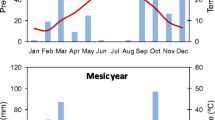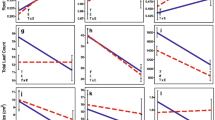Abstract
Plant water-use efficiency (WUE) is expected to affect plant fitness and thus be under natural selection in arid habitats. Although many natural population studies have assessed plant WUE, only a few related WUE to fitness. The further determination of whether selection on WUE is direct or indirect through functionally related traits has yielded no consistent results. For natural populations of two desert annual sunflowers, Helianthus anomalus and H. deserticola, we used phenotypic selection analysis with vegetative biomass as the proxy for fitness to test (1) whether there was direct and indirect selection on WUE (carbon isotope ratio) and related traits (leaf N, area, succulence) and (2) whether direct selection was consistent with hypothesized drought/dehydration escape and avoidance strategies. There was direct selection for lower WUE in mesic and dry H. anomalus populations, consistent with dehydration escape, even though it is the longer lived of the two species. For mesic H. anomalus, direct selection favored lower WUE and higher N, suggesting that plants may be “wasting water” to increase N delivery via the transpiration stream. For the shorter lived H. deserticola in the direr habitat, there was indirect selection for lower WUE, inconsistent with drought escape. There was also direct selection for higher leaf N, succulence and leaf size. There was no direct selection for higher WUE consistent with dehydration avoidance in either species. Thus, in these natural populations of two desert dune species higher fitness was associated with some combination direct and indirect selection for lower WUE, higher leaf N and larger leaf size. Our understanding of the adaptive value of plant ecophysiological traits will benefit from further consideration of related traits such as leaf nitrogen and more tests in natural populations.





Similar content being viewed by others
References
Ackerly DD, Dudley SA, Sultan SE, Schmitt J, Coleman JS, Linder CR, Sandquist DR, Geber MA, Evans AS, Dawson TE, Lechowicz MJ (2000) The evolution of plant ecophysiological traits: recent advances and future directions. BioScience 50:979–995
Arntz AM, Delph LF (2001) Pattern and process: evidence for evolution of photosynthetic traits in natural populations. Oecologia 127:455–467
Blum A (2005) Drought resistance, water-use efficiency, and yield potential—are they compatible, dissonant, or mutually exclusive. Aust J Agric Res 56:1159–1168
Briggs LJ, HL Shantz (1913) The water requirements of plants. II. A review of the literature. USDA Bureau of Plant Industry, bulletin number 284, pp 1–96
Brodie ED III, Moore AJ, Janzen FJ (1995) Visualizing and quantifying natural selection. Trends Ecol Evol 10:313–318
Brouillette LC, Gebremedhin M, Rosenthal DM, Donovan LA (2006) Testing hypothesized evolutionary shifts toward stress tolerance in hybrid Helianthus species. West N Am Nat (in press)
Caird M, Richards JH, McKay JK, Stahl EA, Juenger TE, Donovan LA (2006) Variation among Arabidopsis thaliana accessions in nighttime leaf conductance and correlations with ecophysiological and environmental characters. Plant Cell Environ (in review)
Casper BB, Forseth IN, Wait DA (2005) Variation in carbon isotope discrimination in relation to plant performance in a natural population of Cryptantha flava.. Oecologia 145:541–548
Chapin FS III, Autumn K, Pugnaire F (1993) Evolution of suites of traits in response to environmental stress. Am Nat 142:S78–S92
Chaves MM, Maroco JP, Pereira JS (2003) Understanding plant responses to drought-from genes to whole plant. Funct Plant Biol 30:239–264
Cohen D (1970) The expected efficiency of water utilization in plants under different competition and selection regimes. Israel J Bot 19:50–54
Conner J (1988) Field measurements of natural and sexual selection in the fungus beetle, Bolitotherus cornutus. Evolution 42:736–749
Cowan IR (1982) Regulation of water use in relation to carbon gain in higher plants. In: Lange OL, Nobel PS, Osmond CB, Zeiger H (eds) Water relations and carbon assimilation. Encyclopedia Plant Physiology, NS, (12B). Springer, Berlin Heidelberg New York, pp 589–613
Dixon PM (2000) The bootstrap and the jackknife: describing the precision of ecological indices. In: Scheiner SM, Gurevitch J (eds) Design and analysis of ecological experiments. Oxford University Press, New York, pp 267–288
Donovan LA, Ehleringer JR (1994a) Carbon isotope discrimination, water-use efficiency, growth and mortality in a natural shrub population. Oecologia 100:347–354
Donovan LA, Ehleringer JR (1994b) Potential for selection on plants for water-use efficiency as estimated by carbon isotope discrimination. Am J Bot 81:927–935
Dudley SA (1996) Differing selection on plant physiological traits in response to environmental water availability: a test of adaptive hypotheses. Evolution 50:92–102
Ehleringer JR (1993a) Variation in leaf carbon isotope discrimination in Encelia farinosa: implications for growth, competition, and drought survival. Oecologia 95:340–346
Ehleringer JR (1993b) Carbon and water relations in desert plants: an isotopic perspective. In: Ehleringer JR, Hall AE, Farquhar GD (eds) Stable isotopes and plant carbon–water relations. Academic Press, San Diego, pp 155–172
Ehleringer JR, Clark C (1988) Evolution and adaptation in Encelia (Asteraceae). In: Gottlieb LD, Jain SK (eds) Plant evolutionary biology. Chapman and Hall, London, pp 221–248
Ehleringer JR, Phillips SL, Comstock JP (1992) Seasonal variation in carbon isotope composition of desert plants. Funct Ecol 6:396–404
Farquhar GD, Ehleringer JR, Hubick KT (1989) Carbon isotope discrimination and photosynthesis. Annu Rev Plant Physiol Plant Mol Biol 40:503–537
Field C, Mooney HA (1986) The photosynthesis–nitrogen relationship in wild plants. In: Givnish T (ed) On the economy of plant form and function. Cambridge University Press, New York, pp 25–55
Field C, Merino J, Mooney HA (1983) Compromises between water-use efficiency and nutrient-use efficiency in five species of California evergreens. Oecologia 60:384–389
Geber MA, Dawson TE (1990) Genetic variation in and covariation between leaf gas exchange, morphology, and development in Polygonum arenastrum, an annual plant. Oecologia 85:153–158
Geber MA, Dawson TE (1997) Genetic variation in stomatal and biochemical limitations to photosynthesis in the annual plant, Polygonum arenastrum. Oecologia 109:535–546
Geber MA, Griffen LR (2003) Inheritance and natural selection on functional traits. Int J Plant Sci 164:S21–S42
Gross BL, Schwarzbach AE, Rieseberg LH (2003) Origin(s) of the diploid hybrid species Helianthus deserticola (Asteraceae). Am J Bot 90:1708–1719
Gross BL, Kane NC, Lexer C, Ludwig F, Rosenthal DM. Donovan LA, Rieseberg LH (2004) Reconstructing the origin of Helianthus deserticola: survival and selection on the desert floor. Am Nat 164:145–156
Heschel MS, Riginos C (2005) Mechanisms of selection for drought stress tolerance and avoidance in Impatiens capensis (Balsaminaceae). Am J Bot 92:37–44
Heschel MS, Donohue K, Hausmann N, Schmitt J (2002) Population differentiation and natural selection for water-use efficiency in Impatiens capensis (Balsaminaceae). Int J Plant Sci 163:907–912
Jennings DH (1976) The effects of sodium chloride on higher plants. Biol Rev 51:453–486
Jones HG (1992) Plants and microclimates: a quantitative approach to environmental plat physiology. Cambridge University Press, Cambridge
Kingsolver JG, Hoekstra HE, Hoeskstra JM, Berrigan D, Vignieri SN, Hill CE, Hoang A, Gilbert P, Beerli P (2001) The strength of phenotypic selection on natural populations. Am Nat 157:245–261
Lambers H, Chapin FS III, Pons TL (1998) Plant physiological ecology. Springer, Berlin Heidelberg New York
Lande R, Arnold SJ (1983) The measurement of selection on correlated characters. Evolution 37:1210–1226
Ludlow MM (1989) Strategies of response to water stress. In: KH Kreeb H Richter TM Hinckley (eds) Structural and functional responses to environmental stresses. SPB Academic, The Hague, pp 269–281
Ludwig F, Rosenthal DM, Johnston JA, Kane N, Gross BL, Lexer C, Dudley SA, Rieseberg LH, Donovan LA (2004) Selection on leaf ecophysiological traits in a desert hybrid Helianthus species and early generation hybrids. Evolution 58:2682–2692
Ludwig F, Jewitt RA, Donovan LA (2006) Nutrient and water addition effects on day- and night-time conductance and transpiration in a C3 desert annual. Oecologia 148:219–225
McDonald EP, Erickson JE, Kruger EL (2002) Can decreased transpiration limit plant nitrogen acquisition in elevated CO2? Funct Plant Biol 29:1115–1120
McKay JK, Richards JH, Mitchell-Olds T (2003) Genetics of drought adaptation in Arabidopsis thaliana: I. Pleiotropy contributes to genetic correlations among ecological traits. Mol Ecol 12:1137–1151
Monclus R, Dreyer E, Delmotte FM, Villar M, Delay D, Boudouresque E, Petit J-M, Marron N, Brechet C, Brignolas F (2005) New Phytol 167:53–62
Nelson NS 1987 An acid-persulfate digestion procedure for the determination of phosphorus in sediments. Commun Soil Sci Plant Anal 18:359–369
Nobel PS (1999) Physiochemical and environmental plant physiology. Academic Press, New York
Noy-Meir I (1973) Desert Ecosystems: environment and producers. Ann Rev Ecol Syst 4:25–51
Rieseberg LH, Raymond O, Rosenthal DM, Lai Z, Livingston K, Nakazato T, Durphy JL, Schwarzbach AE, Donovan LA, Lexer C (2003) Major ecological transitions in wild sunflowers facilitated by hybridization. Science 301:1211–1216
Rosenthal DM, Schwarzbach AE, Donovan LA, Raymond O, Rieseberg LH (2002) Phenotypic differentiation between three ancient hybrid taxa and their parental species. Int J Plant Sci 163:387–398
Rosenthal DM, Ludwig F, Donovan L (2005a) Plant responses to an edaphic gradient across an active and dune/desert boundary in the Great Basin desert. Int J Plant Sci 166:247–255
Rosenthal DM, Rieseberg LH, Donovan LA (2005b) Recreating ancient hybrid species’ complex multi-trait phenotypes from early-generation synthetic hybrids: three examples using wild sunflowers. Am Nat 166:26–41
SAS (2001) SAS/STAT user guide version 8.01. SAS institute, Carey
Schuster WSF, Phillips SL, Sandquist DR, Ehleringer JR (1992) Heritability of carbon isotope discrimination in Gutierrezia microcephala (Asteraceae). Am J Bot 79:216–221
Schwarzbach AE, Rieseberg LH (2002) Likely multiple origins of a diploid sunflower species. Mol Ecol 11:1703–1715
Schwarzbach AE, Donovan LA, Rieseberg LH (2001) Transgressive character expression in a hybrid sunflower species. Am J Bot 88:270–277
Sherrard ME, Maherali H (2006) The adaptive significance of drought escape in Avena barbata, an annual grass. Evolution (in press)
Smith JAC (1991) Ion transport and the transpiration stream. Bot Acta 104:416–421
Stanton ML, Roy BA, Thiede DA (2000) Evolution in stressful environments. I. Phenotypic variability, phenotypic selection, and response to selection in five distinct environmental stresses. Evolution 54:93–111
Wright IJ, Reich PB, Westoby M (2003) Least-cost input mixtures of water and nitrogen for photosynthesis. Am Nat 161:98–111
Acknowledgments
We thank Jennifer Lance, Brett Brewer, Stephanie Peglow and Stephanie Scarborough for assistance with field and lab work. We especially thank Peter Chu for providing the program for bootstrapping. Beau Brouillette, Ava Howard and Cara Gormally provided insightful reviews of early drafts. We also thank Ferris Clegg and BLM, Little Sahara Recreation Area, for use of the field site, and Utah State University for use of Tintic Field Station. This project was funded by NSF grant IBN-0131078 to LAD. The experiments comply with the current laws of the country in which they were performed.
Author information
Authors and Affiliations
Corresponding author
Additional information
Communicated by Frederick C. Meinzer.
Rights and permissions
About this article
Cite this article
Donovan, L.A., Dudley, S.A., Rosenthal, D.M. et al. Phenotypic selection on leaf water use efficiency and related ecophysiological traits for natural populations of desert sunflowers. Oecologia 152, 13–25 (2007). https://doi.org/10.1007/s00442-006-0627-5
Received:
Accepted:
Published:
Issue Date:
DOI: https://doi.org/10.1007/s00442-006-0627-5




